Under the unfavourable condition, the Amoeba withdraws its pseudopodia and secretes a three-layered hard covering or cyst around itself . This phenomenon is termed as
Binary fission
Sporulation
Budding
Encystation
The correct Answer is:D
To solve the question regarding the phenomenon in which Amoeba withdraws its pseudopodia and secretes a three-layered hard covering or cyst around itself under unfavorable conditions, we can follow these steps:
1. Understanding the Context:
- The question describes a behavior of Amoeba in response to unfavorable environmental conditions. This behavior involves the formation of a protective covering.
2. Analyzing the Options:
- Binary Fission: This is a method of asexual reproduction where a single organism divides into two parts. This option is not relevant to the formation of a protective covering.
- Sporulation: This refers to the process of forming spores, which is a dormant form of bacteria. This is also not applicable to Amoeba's behavior.
- Budding: This is another form of asexual reproduction where a new organism develops from a part of the parent organism. This does not involve the formation of a cyst.
- Encystment: This is the process where an organism forms a cyst, which is a protective structure, especially under unfavorable conditions.
3. Identifying the Correct Answer:
- Among the given options, encystment is the correct term that describes the phenomenon where Amoeba withdraws its pseudopodia and secretes a hard covering or cyst around itself.
4. Conclusion:
- Therefore, the correct answer to the question is encystment.
Final Answer:
The phenomenon is termed as encystment.
- The question describes a behavior of Amoeba in response to unfavorable environmental conditions. This behavior involves the formation of a protective covering.
- Binary Fission: This is a method of asexual reproduction where a single organism divides into two parts. This option is not relevant to the formation of a protective covering.
- Sporulation: This refers to the process of forming spores, which is a dormant form of bacteria. This is also not applicable to Amoeba's behavior.
- Budding: This is another form of asexual reproduction where a new organism develops from a part of the parent organism. This does not involve the formation of a cyst.
- Encystment: This is the process where an organism forms a cyst, which is a protective structure, especially under unfavorable conditions.
- Among the given options, encystment is the correct term that describes the phenomenon where Amoeba withdraws its pseudopodia and secretes a hard covering or cyst around itself.
- Therefore, the correct answer to the question is encystment.
The phenomenon is termed as encystment.
Similar Questions
Under unfavourable conditions, Amoeba produces a three-layered structure. to tide over the unfavourable environmental conditionsThe phenomenon is
View SolutionDark Snow
Most of Greenland’s interior is covered by a thick layer of ice and compressed snow known as the Greenland Ice Sheet. The size of the ice sheet fluctuates seasonally: in summer, average daily high temperatures in Greenland can rise to slightly above 50 degrees Fahrenheit, partially melting the ice, in the winter, the sheet thickens as additional snow falls, and average daily low temperatures can drop to (12) as low as 20 degrees–––––––––––––––––––––.
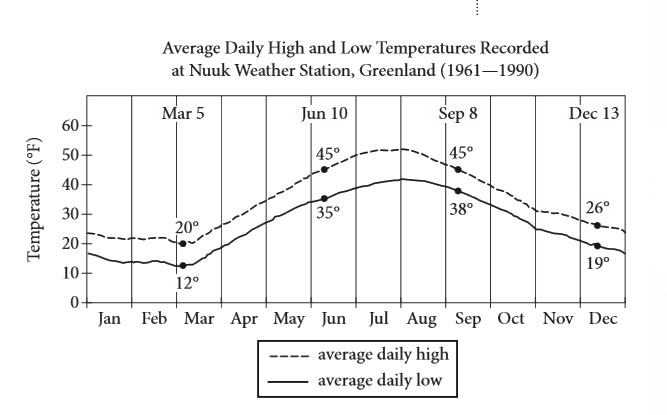
Typically, the ice sheet begins to show evidence of thawing in late (13)summer. This follows––––––––––––––––––––––– several weeks of higher temperatures. 14 For example––––––––––––––, in the summer of 2012, virtually the entire Greenland Ice Sheet underwent thawing at or near its surface by mid-July, the earliest date on record. Most scientists looking for the causes of the Great Melt of 2012 have focused exclusively on rising temperatures. The summer of 2012 was the warmest in 170 years, records show. But Jason (15) Box, an associate––––––––––––––––––– professor of geology at Ohio State believes that another factor added to the early (16) (thaw), the “dark snow” problem.
According to Box, a leading Greenland expert, tundra fires in 2012 from as far away as North America produced great amounts of soot, some (17) of it–––––drifted over Greenland in giant plumes of smoke and then (18) fell–––– as particles onto the ice sheet. Scientists have long known that soot particles facilitate melting by darkening snow and ice, limiting (19) it’s–––– ability to reflect the Sun’s rays. As Box explains, “Soot is an extremely powerful light absorber. It settles over the ice and captures the Sun’s heat.” The result is a self-reinforcing cycle. As the ice melts, the land and water under the ice become exposed, and since land and water are darker than snow, the surface absorbs even more heat, which (20) is related to the rising temperatures–––––––––––––––––––––––––––––––––––––––.
[1] Box’s research is important because the fires of 2012 may not be a one-time phenomenon. [2] According to scientists, rising Arctic temperatures are making northern latitudes greener and thus more fire prone.[3] The pattern Box observed in 2012 may repeat (21) itself again––––––––––––, with harmful effects on the Arctic ecosystem. [4] Box is currently organizing an expedition to gather this crucial information. [5] The next step for Box and his team is to travel to Greenland to perform direct sampling of the ice in order to determine just how much the soot is contributing to the melting of the ice sheet. [6] Members of the public will be able to track his team’s progress—and even help fund the expedition—through a website Box has created. (22)
View Solution
Knowledge Check
Dark Snow
Most of Greenland’s interior is covered by a thick layer of ice and compressed snow known as the Greenland Ice Sheet. The size of the ice sheet fluctuates seasonally: in summer, average daily high temperatures in Greenland can rise to slightly above 50 degrees Fahrenheit, partially melting the ice, in the winter, the sheet thickens as additional snow falls, and average daily low temperatures can drop to (12) as low as 20 degrees–––––––––––––––––––––.
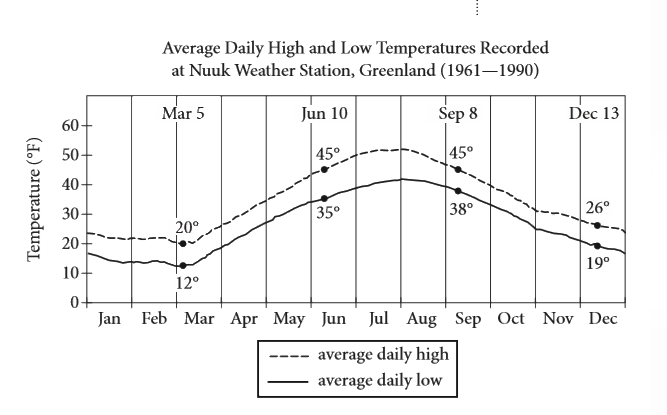
Typically, the ice sheet begins to show evidence of thawing in late (13)summer. This follows––––––––––––––––––––––– several weeks of higher temperatures. 14 For example––––––––––––––, in the summer of 2012, virtually the entire Greenland Ice Sheet underwent thawing at or near its surface by mid-July, the earliest date on record. Most scientists looking for the causes of the Great Melt of 2012 have focused exclusively on rising temperatures. The summer of 2012 was the warmest in 170 years, records show. But Jason (15) Box, an associate––––––––––––––––––– professor of geology at Ohio State believes that another factor added to the early (16) (thaw), the “dark snow” problem.
According to Box, a leading Greenland expert, tundra fires in 2012 from as far away as North America produced great amounts of soot, some (17) of it–––––drifted over Greenland in giant plumes of smoke and then (18) fell–––– as particles onto the ice sheet. Scientists have long known that soot particles facilitate melting by darkening snow and ice, limiting (19) it’s–––– ability to reflect the Sun’s rays. As Box explains, “Soot is an extremely powerful light absorber. It settles over the ice and captures the Sun’s heat.” The result is a self-reinforcing cycle. As the ice melts, the land and water under the ice become exposed, and since land and water are darker than snow, the surface absorbs even more heat, which (20) is related to the rising temperatures–––––––––––––––––––––––––––––––––––––––.
[1] Box’s research is important because the fires of 2012 may not be a one-time phenomenon. [2] According to scientists, rising Arctic temperatures are making northern latitudes greener and thus more fire prone.[3] The pattern Box observed in 2012 may repeat (21) itself again––––––––––––, with harmful effects on the Arctic ecosystem. [4] Box is currently organizing an expedition to gather this crucial information. [5] The next step for Box and his team is to travel to Greenland to perform direct sampling of the ice in order to determine just how much the soot is contributing to the melting of the ice sheet. [6] Members of the public will be able to track his team’s progress—and even help fund the expedition—through a website Box has created. (22)ANO CHANGEBsootCof whichDDELETE the underlined portion.Dark Snow
Most of Greenland’s interior is covered by a thick layer of ice and compressed snow known as the Greenland Ice Sheet. The size of the ice sheet fluctuates seasonally: in summer, average daily high temperatures in Greenland can rise to slightly above 50 degrees Fahrenheit, partially melting the ice, in the winter, the sheet thickens as additional snow falls, and average daily low temperatures can drop to (12) as low as 20 degrees–––––––––––––––––––––.

Typically, the ice sheet begins to show evidence of thawing in late (13)summer. This follows––––––––––––––––––––––– several weeks of higher temperatures. 14 For example––––––––––––––, in the summer of 2012, virtually the entire Greenland Ice Sheet underwent thawing at or near its surface by mid-July, the earliest date on record. Most scientists looking for the causes of the Great Melt of 2012 have focused exclusively on rising temperatures. The summer of 2012 was the warmest in 170 years, records show. But Jason (15) Box, an associate––––––––––––––––––– professor of geology at Ohio State believes that another factor added to the early (16) (thaw), the “dark snow” problem.
According to Box, a leading Greenland expert, tundra fires in 2012 from as far away as North America produced great amounts of soot, some (17) of it–––––drifted over Greenland in giant plumes of smoke and then (18) fell–––– as particles onto the ice sheet. Scientists have long known that soot particles facilitate melting by darkening snow and ice, limiting (19) it’s–––– ability to reflect the Sun’s rays. As Box explains, “Soot is an extremely powerful light absorber. It settles over the ice and captures the Sun’s heat.” The result is a self-reinforcing cycle. As the ice melts, the land and water under the ice become exposed, and since land and water are darker than snow, the surface absorbs even more heat, which (20) is related to the rising temperatures–––––––––––––––––––––––––––––––––––––––.
[1] Box’s research is important because the fires of 2012 may not be a one-time phenomenon. [2] According to scientists, rising Arctic temperatures are making northern latitudes greener and thus more fire prone.[3] The pattern Box observed in 2012 may repeat (21) itself again––––––––––––, with harmful effects on the Arctic ecosystem. [4] Box is currently organizing an expedition to gather this crucial information. [5] The next step for Box and his team is to travel to Greenland to perform direct sampling of the ice in order to determine just how much the soot is contributing to the melting of the ice sheet. [6] Members of the public will be able to track his team’s progress—and even help fund the expedition—through a website Box has created. (22)ANO CHANGEBBox an associate professor of geology at Ohio State,CBox, an associate professor of geology at Ohio State,DBox, an associate professor of geology, at Ohio StateDark Snow
Most of Greenland’s interior is covered by a thick layer of ice and compressed snow known as the Greenland Ice Sheet. The size of the ice sheet fluctuates seasonally: in summer, average daily high temperatures in Greenland can rise to slightly above 50 degrees Fahrenheit, partially melting the ice, in the winter, the sheet thickens as additional snow falls, and average daily low temperatures can drop to (12) as low as 20 degrees–––––––––––––––––––––.
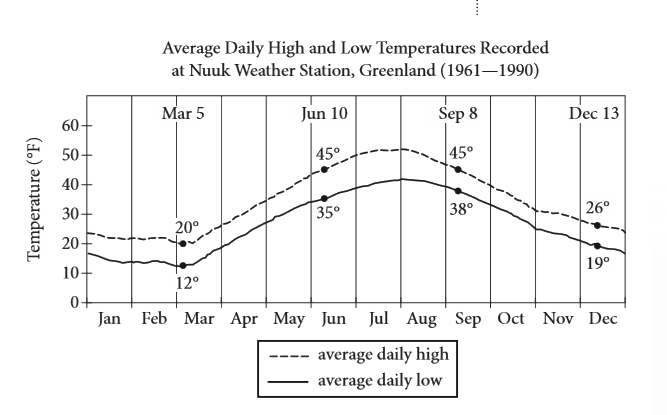
Typically, the ice sheet begins to show evidence of thawing in late (13)summer. This follows––––––––––––––––––––––– several weeks of higher temperatures. 14 For example––––––––––––––, in the summer of 2012, virtually the entire Greenland Ice Sheet underwent thawing at or near its surface by mid-July, the earliest date on record. Most scientists looking for the causes of the Great Melt of 2012 have focused exclusively on rising temperatures. The summer of 2012 was the warmest in 170 years, records show. But Jason (15) Box, an associate––––––––––––––––––– professor of geology at Ohio State believes that another factor added to the early (16) (thaw), the “dark snow” problem.
According to Box, a leading Greenland expert, tundra fires in 2012 from as far away as North America produced great amounts of soot, some (17) of it–––––drifted over Greenland in giant plumes of smoke and then (18) fell–––– as particles onto the ice sheet. Scientists have long known that soot particles facilitate melting by darkening snow and ice, limiting (19) it’s–––– ability to reflect the Sun’s rays. As Box explains, “Soot is an extremely powerful light absorber. It settles over the ice and captures the Sun’s heat.” The result is a self-reinforcing cycle. As the ice melts, the land and water under the ice become exposed, and since land and water are darker than snow, the surface absorbs even more heat, which (20) is related to the rising temperatures–––––––––––––––––––––––––––––––––––––––.
[1] Box’s research is important because the fires of 2012 may not be a one-time phenomenon. [2] According to scientists, rising Arctic temperatures are making northern latitudes greener and thus more fire prone.[3] The pattern Box observed in 2012 may repeat (21) itself again––––––––––––, with harmful effects on the Arctic ecosystem. [4] Box is currently organizing an expedition to gather this crucial information. [5] The next step for Box and his team is to travel to Greenland to perform direct sampling of the ice in order to determine just how much the soot is contributing to the melting of the ice sheet. [6] Members of the public will be able to track his team’s progress—and even help fund the expedition—through a website Box has created. (22)ANO CHANGEBfallsCwill fallDhad fallen
Dark Snow
Most of Greenland’s interior is covered by a thick layer of ice and compressed snow known as the Greenland Ice Sheet. The size of the ice sheet fluctuates seasonally: in summer, average daily high temperatures in Greenland can rise to slightly above 50 degrees Fahrenheit, partially melting the ice, in the winter, the sheet thickens as additional snow falls, and average daily low temperatures can drop to (12) as low as 20 degrees–––––––––––––––––––––.

Typically, the ice sheet begins to show evidence of thawing in late (13)summer. This follows––––––––––––––––––––––– several weeks of higher temperatures. 14 For example––––––––––––––, in the summer of 2012, virtually the entire Greenland Ice Sheet underwent thawing at or near its surface by mid-July, the earliest date on record. Most scientists looking for the causes of the Great Melt of 2012 have focused exclusively on rising temperatures. The summer of 2012 was the warmest in 170 years, records show. But Jason (15) Box, an associate––––––––––––––––––– professor of geology at Ohio State believes that another factor added to the early (16) (thaw), the “dark snow” problem.
According to Box, a leading Greenland expert, tundra fires in 2012 from as far away as North America produced great amounts of soot, some (17) of it–––––drifted over Greenland in giant plumes of smoke and then (18) fell–––– as particles onto the ice sheet. Scientists have long known that soot particles facilitate melting by darkening snow and ice, limiting (19) it’s–––– ability to reflect the Sun’s rays. As Box explains, “Soot is an extremely powerful light absorber. It settles over the ice and captures the Sun’s heat.” The result is a self-reinforcing cycle. As the ice melts, the land and water under the ice become exposed, and since land and water are darker than snow, the surface absorbs even more heat, which (20) is related to the rising temperatures–––––––––––––––––––––––––––––––––––––––.
[1] Box’s research is important because the fires of 2012 may not be a one-time phenomenon. [2] According to scientists, rising Arctic temperatures are making northern latitudes greener and thus more fire prone.[3] The pattern Box observed in 2012 may repeat (21) itself again––––––––––––, with harmful effects on the Arctic ecosystem. [4] Box is currently organizing an expedition to gather this crucial information. [5] The next step for Box and his team is to travel to Greenland to perform direct sampling of the ice in order to determine just how much the soot is contributing to the melting of the ice sheet. [6] Members of the public will be able to track his team’s progress—and even help fund the expedition—through a website Box has created. (22)
22. To make this paragraph most logical, sentence 4 should be placed
View SolutionDark Snow
Most of Greenland’s interior is covered by a thick layer of ice and compressed snow known as the Greenland Ice Sheet. The size of the ice sheet fluctuates seasonally: in summer, average daily high temperatures in Greenland can rise to slightly above 50 degrees Fahrenheit, partially melting the ice, in the winter, the sheet thickens as additional snow falls, and average daily low temperatures can drop to (12) as low as 20 degrees–––––––––––––––––––––.

Typically, the ice sheet begins to show evidence of thawing in late (13)summer. This follows––––––––––––––––––––––– several weeks of higher temperatures. 14 For example––––––––––––––, in the summer of 2012, virtually the entire Greenland Ice Sheet underwent thawing at or near its surface by mid-July, the earliest date on record. Most scientists looking for the causes of the Great Melt of 2012 have focused exclusively on rising temperatures. The summer of 2012 was the warmest in 170 years, records show. But Jason (15) Box, an associate––––––––––––––––––– professor of geology at Ohio State believes that another factor added to the early (16) (thaw), the “dark snow” problem.
According to Box, a leading Greenland expert, tundra fires in 2012 from as far away as North America produced great amounts of soot, some (17) of it–––––drifted over Greenland in giant plumes of smoke and then (18) fell–––– as particles onto the ice sheet. Scientists have long known that soot particles facilitate melting by darkening snow and ice, limiting (19) it’s–––– ability to reflect the Sun’s rays. As Box explains, “Soot is an extremely powerful light absorber. It settles over the ice and captures the Sun’s heat.” The result is a self-reinforcing cycle. As the ice melts, the land and water under the ice become exposed, and since land and water are darker than snow, the surface absorbs even more heat, which (20) is related to the rising temperatures–––––––––––––––––––––––––––––––––––––––.
[1] Box’s research is important because the fires of 2012 may not be a one-time phenomenon. [2] According to scientists, rising Arctic temperatures are making northern latitudes greener and thus more fire prone.[3] The pattern Box observed in 2012 may repeat (21) itself again––––––––––––, with harmful effects on the Arctic ecosystem. [4] Box is currently organizing an expedition to gather this crucial information. [5] The next step for Box and his team is to travel to Greenland to perform direct sampling of the ice in order to determine just how much the soot is contributing to the melting of the ice sheet. [6] Members of the public will be able to track his team’s progress—and even help fund the expedition—through a website Box has created. (22)
View SolutionDark Snow
Most of Greenland’s interior is covered by a thick layer of ice and compressed snow known as the Greenland Ice Sheet. The size of the ice sheet fluctuates seasonally: in summer, average daily high temperatures in Greenland can rise to slightly above 50 degrees Fahrenheit, partially melting the ice, in the winter, the sheet thickens as additional snow falls, and average daily low temperatures can drop to (12) as low as 20 degrees–––––––––––––––––––––.
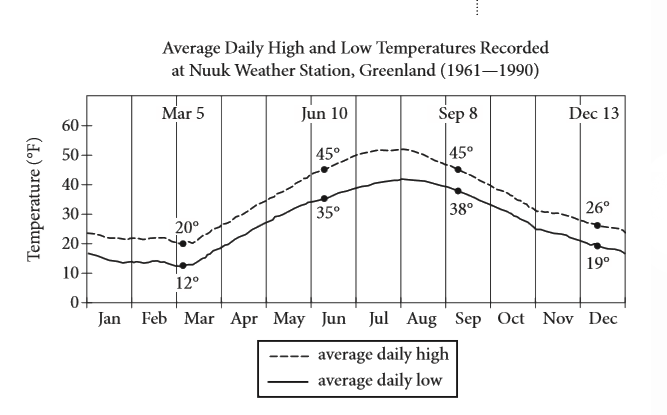
Typically, the ice sheet begins to show evidence of thawing in late (13)summer. This follows––––––––––––––––––––––– several weeks of higher temperatures. 14 For example––––––––––––––, in the summer of 2012, virtually the entire Greenland Ice Sheet underwent thawing at or near its surface by mid-July, the earliest date on record. Most scientists looking for the causes of the Great Melt of 2012 have focused exclusively on rising temperatures. The summer of 2012 was the warmest in 170 years, records show. But Jason (15) Box, an associate––––––––––––––––––– professor of geology at Ohio State believes that another factor added to the early (16) (thaw), the “dark snow” problem.
According to Box, a leading Greenland expert, tundra fires in 2012 from as far away as North America produced great amounts of soot, some (17) of it–––––drifted over Greenland in giant plumes of smoke and then (18) fell–––– as particles onto the ice sheet. Scientists have long known that soot particles facilitate melting by darkening snow and ice, limiting (19) it’s–––– ability to reflect the Sun’s rays. As Box explains, “Soot is an extremely powerful light absorber. It settles over the ice and captures the Sun’s heat.” The result is a self-reinforcing cycle. As the ice melts, the land and water under the ice become exposed, and since land and water are darker than snow, the surface absorbs even more heat, which (20) is related to the rising temperatures–––––––––––––––––––––––––––––––––––––––.
[1] Box’s research is important because the fires of 2012 may not be a one-time phenomenon. [2] According to scientists, rising Arctic temperatures are making northern latitudes greener and thus more fire prone.[3] The pattern Box observed in 2012 may repeat (21) itself again––––––––––––, with harmful effects on the Arctic ecosystem. [4] Box is currently organizing an expedition to gather this crucial information. [5] The next step for Box and his team is to travel to Greenland to perform direct sampling of the ice in order to determine just how much the soot is contributing to the melting of the ice sheet. [6] Members of the public will be able to track his team’s progress—and even help fund the expedition—through a website Box has created. (22)
View SolutionDark Snow
Most of Greenland’s interior is covered by a thick layer of ice and compressed snow known as the Greenland Ice Sheet. The size of the ice sheet fluctuates seasonally: in summer, average daily high temperatures in Greenland can rise to slightly above 50 degrees Fahrenheit, partially melting the ice, in the winter, the sheet thickens as additional snow falls, and average daily low temperatures can drop to (12) as low as 20 degrees–––––––––––––––––––––.
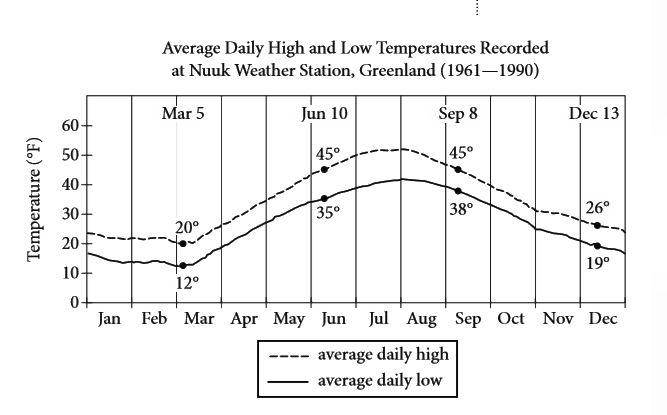
Typically, the ice sheet begins to show evidence of thawing in late (13)summer. This follows––––––––––––––––––––––– several weeks of higher temperatures. 14 For example––––––––––––––, in the summer of 2012, virtually the entire Greenland Ice Sheet underwent thawing at or near its surface by mid-July, the earliest date on record. Most scientists looking for the causes of the Great Melt of 2012 have focused exclusively on rising temperatures. The summer of 2012 was the warmest in 170 years, records show. But Jason (15) Box, an associate––––––––––––––––––– professor of geology at Ohio State believes that another factor added to the early (16) (thaw), the “dark snow” problem.
According to Box, a leading Greenland expert, tundra fires in 2012 from as far away as North America produced great amounts of soot, some (17) of it–––––drifted over Greenland in giant plumes of smoke and then (18) fell–––– as particles onto the ice sheet. Scientists have long known that soot particles facilitate melting by darkening snow and ice, limiting (19) it’s–––– ability to reflect the Sun’s rays. As Box explains, “Soot is an extremely powerful light absorber. It settles over the ice and captures the Sun’s heat.” The result is a self-reinforcing cycle. As the ice melts, the land and water under the ice become exposed, and since land and water are darker than snow, the surface absorbs even more heat, which (20) is related to the rising temperatures–––––––––––––––––––––––––––––––––––––––.
[1] Box’s research is important because the fires of 2012 may not be a one-time phenomenon. [2] According to scientists, rising Arctic temperatures are making northern latitudes greener and thus more fire prone.[3] The pattern Box observed in 2012 may repeat (21) itself again––––––––––––, with harmful effects on the Arctic ecosystem. [4] Box is currently organizing an expedition to gather this crucial information. [5] The next step for Box and his team is to travel to Greenland to perform direct sampling of the ice in order to determine just how much the soot is contributing to the melting of the ice sheet. [6] Members of the public will be able to track his team’s progress—and even help fund the expedition—through a website Box has created. (22)
12. Which choice most accurately and effectively represents the information in the graph?
View SolutionDark Snow
Most of Greenland’s interior is covered by a thick layer of ice and compressed snow known as the Greenland Ice Sheet. The size of the ice sheet fluctuates seasonally: in summer, average daily high temperatures in Greenland can rise to slightly above 50 degrees Fahrenheit, partially melting the ice, in the winter, the sheet thickens as additional snow falls, and average daily low temperatures can drop to (12) as low as 20 degrees–––––––––––––––––––––.
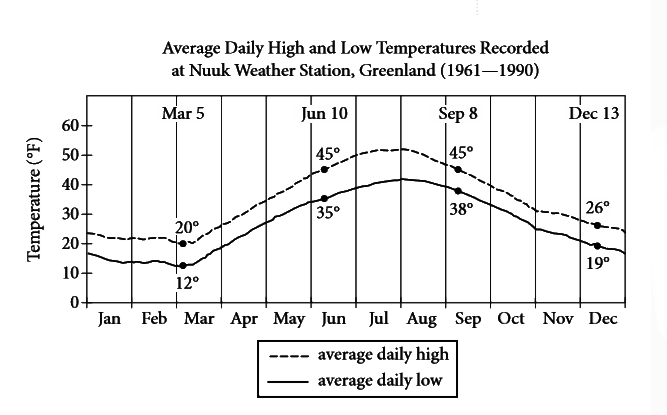
Typically, the ice sheet begins to show evidence of thawing in late (13)summer. This follows––––––––––––––––––––––– several weeks of higher temperatures. 14 For example––––––––––––––, in the summer of 2012, virtually the entire Greenland Ice Sheet underwent thawing at or near its surface by mid-July, the earliest date on record. Most scientists looking for the causes of the Great Melt of 2012 have focused exclusively on rising temperatures. The summer of 2012 was the warmest in 170 years, records show. But Jason (15) Box, an associate––––––––––––––––––– professor of geology at Ohio State believes that another factor added to the early (16) (thaw), the “dark snow” problem.
According to Box, a leading Greenland expert, tundra fires in 2012 from as far away as North America produced great amounts of soot, some (17) of it–––––drifted over Greenland in giant plumes of smoke and then (18) fell–––– as particles onto the ice sheet. Scientists have long known that soot particles facilitate melting by darkening snow and ice, limiting (19) it’s–––– ability to reflect the Sun’s rays. As Box explains, “Soot is an extremely powerful light absorber. It settles over the ice and captures the Sun’s heat.” The result is a self-reinforcing cycle. As the ice melts, the land and water under the ice become exposed, and since land and water are darker than snow, the surface absorbs even more heat, which (20) is related to the rising temperatures–––––––––––––––––––––––––––––––––––––––.
[1] Box’s research is important because the fires of 2012 may not be a one-time phenomenon. [2] According to scientists, rising Arctic temperatures are making northern latitudes greener and thus more fire prone.[3] The pattern Box observed in 2012 may repeat (21) itself again––––––––––––, with harmful effects on the Arctic ecosystem. [4] Box is currently organizing an expedition to gather this crucial information. [5] The next step for Box and his team is to travel to Greenland to perform direct sampling of the ice in order to determine just how much the soot is contributing to the melting of the ice sheet. [6] Members of the public will be able to track his team’s progress—and even help fund the expedition—through a website Box has created. (22)
13. Which choice most effectively combines the two sentences at the underlined portion?
View Solution
